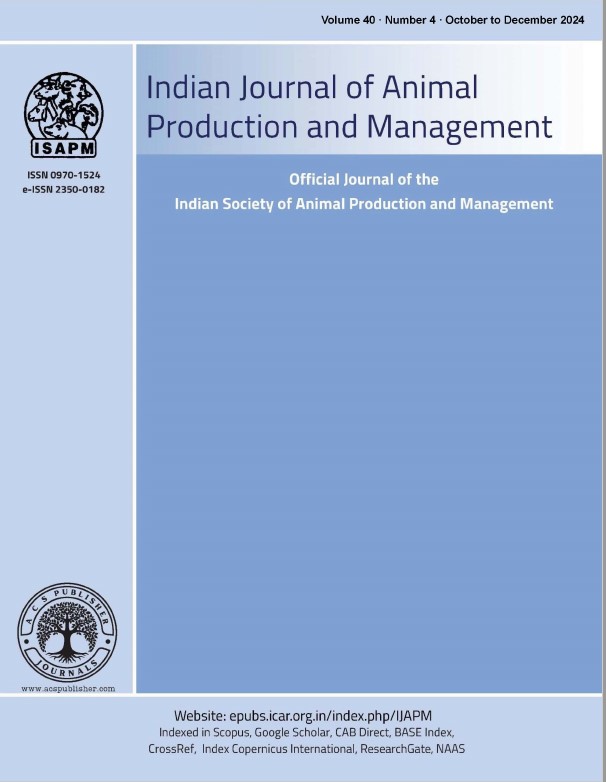The polymorphism of ANXA9 gene and its relationship with body dimensions in Awassi Sheep
DOI:
https://doi.org/10.48165/ijapm.2025.41.2.8Keywords:
ANXA9 gene, SNPs, Body dimensions, Awassi sheepAbstract
This study was conducted at the sheep and goat breeding station in Shatrah city, Thi Qar Governorate, southern Iraq, and included 39 Awassi ewes aged 2-4 years. The aim of the research was to study the effect of the polymorphism of the ANXA9 gene on some body dimension traits in Awassi sheep to benefit from it in early selection for these traits. Blood samples were collected from the jugular vein of each animal, and then the genetic material (DNA) was extracted from them. Then, the targeted segment of the studied gene was amplified using PCR technology and electrophoresis was performed to confirm the size of the targeted segment of the gene in the Molecular Genetics Laboratory of Thi Qar University. The results showed the presence of three variations (SNPs) in the targeted segment (172 C/G, , 385 G/T,393G/C) occurred in intron 4 of chromosome 1in sheep. The three SNPs did not differ significantly between their genotypes according to the resulting Chi-square value. The first mutation (GC) had no significant effect on the studied body dimensions, while the GT mutation showed a significant effect on the body length, chest and abdominal circumference traits in sheep. There was also a significant difference for the CG mutation in the front and rear height traits of sheep, which indicates the possibility of using them as selective indicators for these traits in Awassi sheep.
References
Acquaah, G. (2012). Principles of plant genetics and breeding (2nd ed.). Wiley-Blackwell.
Almaamory, Y. A., & Al-Anbari, N. N. (2023). Association of ANXA9 gene polymorphism with some economic traits of Awassi sheep. Iraqi Journal of Market Research and Consumer Protection, 15(1), 260–267.
Duncan, D. B. (1955). Multiple range and multiple F tests. Biometrics, 11(1), 1–42.
Falconer, D. S., & Mackay, T. F. C. (1996). Introduction to quantitative genetics (4th ed.). Longman, Harlow, UK.
Gerke, V., Creutz, C. E., & Moss, S. E. (2005). Annexins: Linking Ca2+ signalling to membrane dynamics. Nature Reviews Molecular Cell Biology, 6(6), 449–461.
Grewal, T., Enrich, C., Rentero, C., & Buechler, C. (2019). Annexins in adipose tissue: Novel players in obesity. International Journal of Molecular Sciences, 20(14), 3449.
Jameel, D. S., & Salim, A. H. (2025). Study the polymorphism of ACACA gene and its effect on milk production traits in goats. IOP Conference Series: Earth and Environmental Science, 1487(1), 012159.
Rigau, M., Juan, D., & Valencia, A. (2019). Intronic CNVs and gene expression variation in human populations. PLoS Genetics, 7(3), 100.
Salam, L. A., Abdulla, A. N., & Sunkal, R. H. (2022). Relationship of LHX3 gene polymorphism to fertility rate in local and Shami goats. Iraqi Journal of Market Research and Consumer Protection, 14(2), 19–25.
SAS. (2018). Statistical analysis system, user’s guide (Version 9, 4th ed.). SAS Institute Inc., Cary, N.C., USA.
Visscher, P. M., Brown, M. A., MaCarthy, M. I., & Yang, J. (2012). Five years of GWAS discovery. The American Journal of Human Genetics, 90(1), 7–24. https://doi.org/j.ajhg.2011.11.029
Wang, Y., Zhang, C., & Wu, J. (2020). Identification of polymorphisms in the ANAXA9 gene and their association with growth traits in cattle. Genes and Genomics, 42, 1243–1251.

